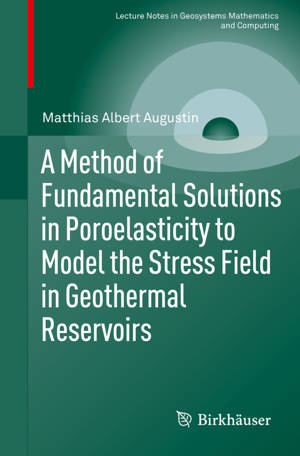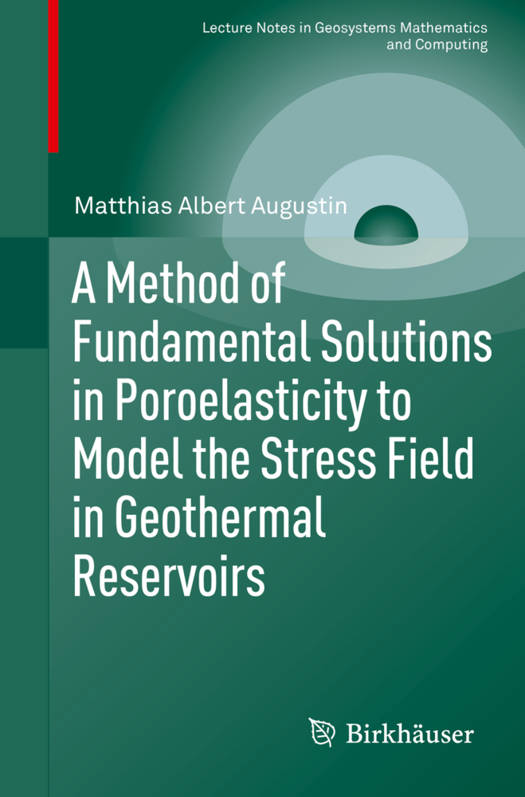
- Afhalen na 1 uur in een winkel met voorraad
- Gratis thuislevering in België vanaf € 30
- Ruim aanbod met 7 miljoen producten
- Afhalen na 1 uur in een winkel met voorraad
- Gratis thuislevering in België vanaf € 30
- Ruim aanbod met 7 miljoen producten
Zoeken
A Method of Fundamental Solutions in Poroelasticity to Model the Stress Field in Geothermal Reservoirs
Matthias Albert Augustin
€ 52,95
+ 105 punten
Omschrijving
This monograph focuses on the numerical methods needed in the context of developing a reliable simulation tool to promote the use of renewable energy. One very promising source of energy is the heat stored in the Earth's crust, which is harnessed by so-called geothermal facilities. Scientists from fields like geology, geo-engineering, geophysics and especially geomathematics are called upon to help make geothermics a reliable and safe energy production method. One of the challenges they face involves modeling the mechanical stresses at work in a reservoir.
The aim of this thesis is to develop a numerical solution scheme by means of which the fluid pressure and rock stresses in a geothermal reservoir can be determined prior to well drilling and during production. For this purpose, the method should (i) include poroelastic effects, (ii) provide a means of including thermoelastic effects, (iii) be inexpensive in terms of memory and computational power, and (iv) be flexible with regard to the locations of data points.
After introducing the basic equations and their relations to more familiar ones (the heat equation, Stokes equations, Cauchy-Navier equation), the "method of fundamental solutions" and its potential value concerning our task are discussed. Based on the properties of the fundamental solutions, theoretical results are established and numerical examples of stress field simulations are presented to assess the method's performance. The first-ever 3D graphics calculated for these topics, which neither requiring meshing of the domain nor involving a time-stepping scheme, make this a pioneering volume.
The aim of this thesis is to develop a numerical solution scheme by means of which the fluid pressure and rock stresses in a geothermal reservoir can be determined prior to well drilling and during production. For this purpose, the method should (i) include poroelastic effects, (ii) provide a means of including thermoelastic effects, (iii) be inexpensive in terms of memory and computational power, and (iv) be flexible with regard to the locations of data points.
After introducing the basic equations and their relations to more familiar ones (the heat equation, Stokes equations, Cauchy-Navier equation), the "method of fundamental solutions" and its potential value concerning our task are discussed. Based on the properties of the fundamental solutions, theoretical results are established and numerical examples of stress field simulations are presented to assess the method's performance. The first-ever 3D graphics calculated for these topics, which neither requiring meshing of the domain nor involving a time-stepping scheme, make this a pioneering volume.
Specificaties
Betrokkenen
- Auteur(s):
- Uitgeverij:
Inhoud
- Aantal bladzijden:
- 235
- Taal:
- Engels
- Reeks:
Eigenschappen
- Productcode (EAN):
- 9783319170787
- Verschijningsdatum:
- 23/07/2015
- Uitvoering:
- Paperback
- Formaat:
- Trade paperback (VS)
- Afmetingen:
- 156 mm x 234 mm
- Gewicht:
- 353 g

Alleen bij Standaard Boekhandel
+ 105 punten op je klantenkaart van Standaard Boekhandel
Beoordelingen
We publiceren alleen reviews die voldoen aan de voorwaarden voor reviews. Bekijk onze voorwaarden voor reviews.











